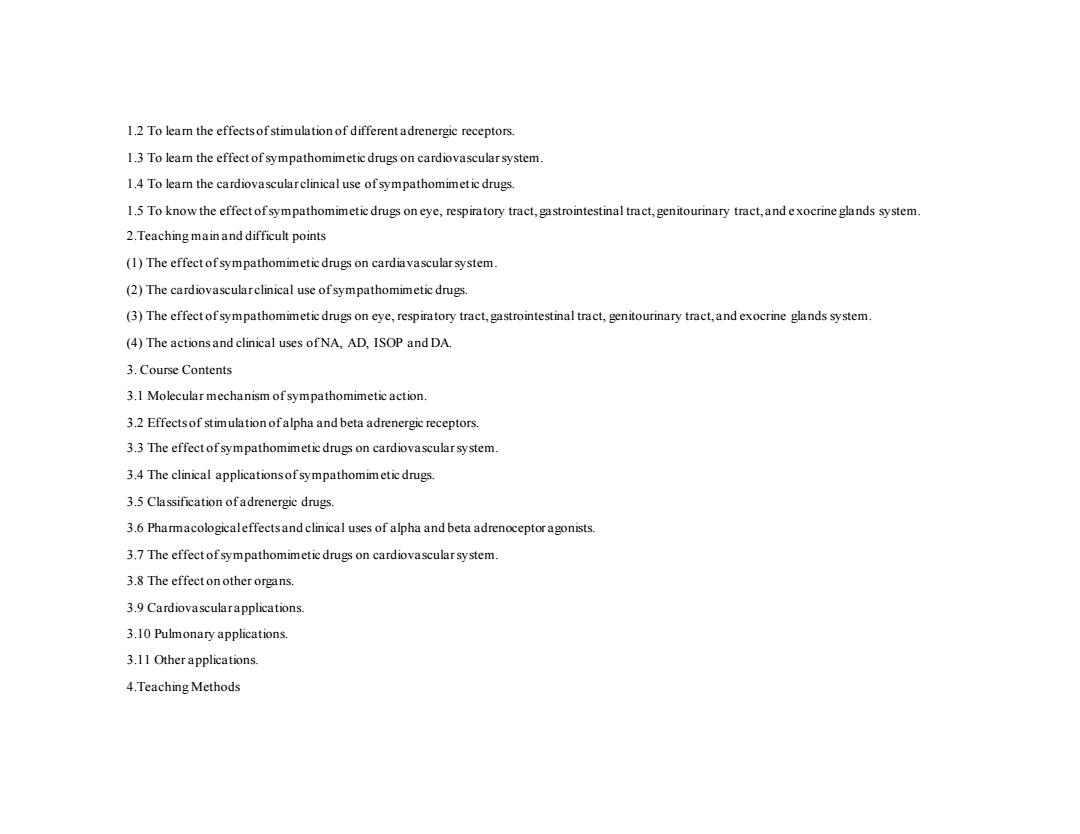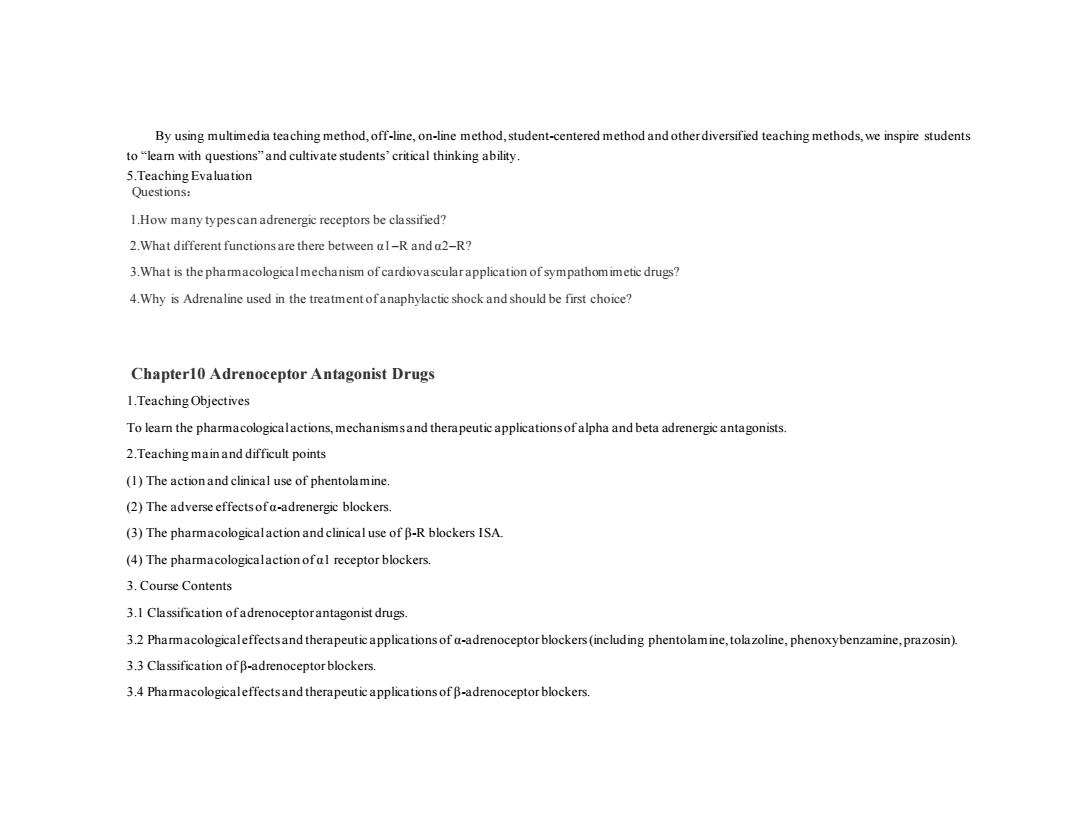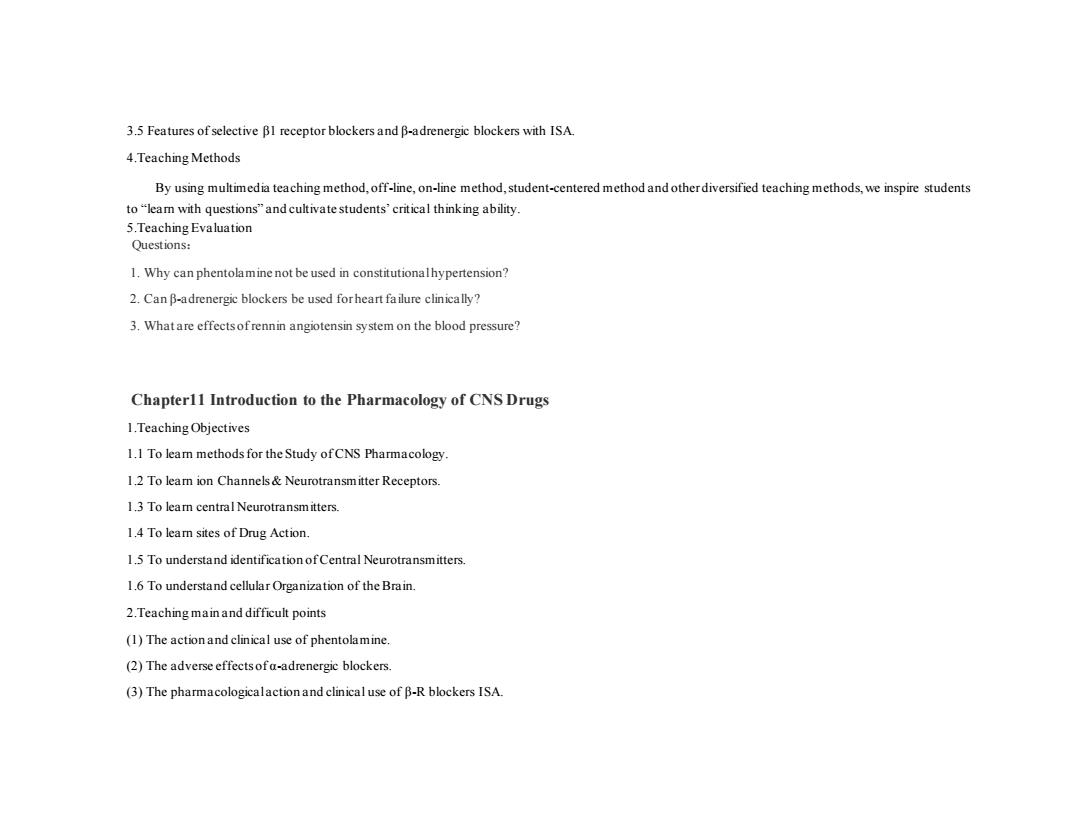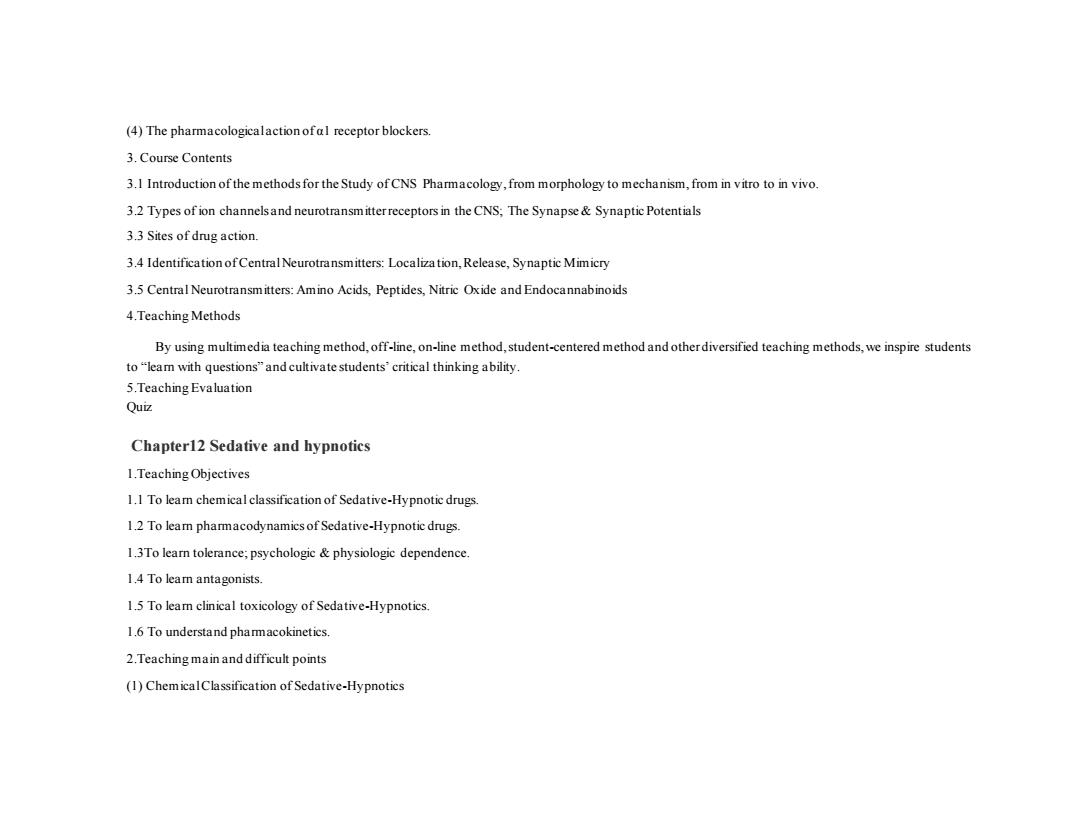
12 To learn the effects ofstimulation of different adrenergic receptors. 1.3 To leam the effect of sympathomimetic drugs on cardiovascular system. 1.4 To learn the cardiovascularclinical use of sympathomimetic drugs. 1.5 To know the effect ofsympathomimetic drugs on eye,respiratory tract,gastrointestinal tract,genitourinary tract,and exocrine glands system. 2.Teaching mainand difficult points (1)The effect ofsympathomimetic drugs on cardiavascular system. (2)The cardiovascularclinical use of sympathomimetic drugs. (3)The effect ofsympathomimetic drugs on eye,respiratory tract,gastrointestinal tract,genitourinary tract,and exocrine glands system. (4)The actionsand clinical uses ofNA,AD,ISOP and DA. 3.Course Contents 3.1 Molecular mechanism ofsympathomimetic action. 3.2 Effectsof stimulation ofalpha and beta adrenergic receptors. 3.3 The effect of sympathomimetic drugs on cardiovascular system. 3.4 The clinical applicationsofsympathomimetic drugs. 3.5 Classification ofadrenergic drugs. 3.6 Pharmacologicaleffectsand clinical uses of alpha and beta adrenoceptor agonists. 3.7 The effect of sympathomimetic drugs on cardiovascular system. 3.8 The effect on other organs. 3.9 Cardiovascularapplications. 3.10 Pulmonary applications. 3.11 Other applications. 4.Teaching Methods
1.2 To learn the effects of stimulation of different adrenergic receptors. 1.3 To learn the effect of sympathomimetic drugs on cardiovascular system. 1.4 To learn the cardiovascular clinical use of sympathomimetic drugs. 1.5 To know the effect of sympathomimetic drugs on eye, respiratory tract, gastrointestinal tract, genitourinary tract, and e xocrine glands system. 2.Teaching main and difficult points (1) The effect of sympathomimetic drugs on cardiavascular system. (2) The cardiovascular clinical use of sympathomimetic drugs. (3) The effect of sympathomimetic drugs on eye, respiratory tract, gastrointestinal tract, genitourinary tract, and exocrine glands system. (4) The actions and clinical uses of NA, AD, ISOP and DA. 3. Course Contents 3.1 Molecular mechanism of sympathomimetic action. 3.2 Effects of stimulation of alpha and beta adrenergic receptors. 3.3 The effect of sympathomimetic drugs on cardiovascular system. 3.4 The clinical applications of sympathomimetic drugs. 3.5 Classification of adrenergic drugs. 3.6 Pharmacological effects and clinical uses of alpha and beta adrenoceptor agonists. 3.7 The effect of sympathomimetic drugs on cardiovascular system. 3.8 The effect on other organs. 3.9 Cardiovascular applications. 3.10 Pulmonary applications. 3.11 Other applications. 4.Teaching Methods

By using multimedia teaching method,off-line,on-line method,student-centered method and otherdiversified teaching methods,we inspire students to"leam with questions"and cultivate students'critical thinking ability. 5.Teaching Evaluation Questions: 1.How many typescan adrenergic receptors be classified? 2.What different functions are there between al-R and a2-R? 3.What is the pharmacologicalmechanism of cardiovascular application of sympathomimetic drugs? 4.Why is Adrenaline used in the treatment ofanaphylactic shock and should be first choice? Chapter10 Adrenoceptor Antagonist Drugs 1.Teaching Objectives To learn the pharmacologicalactions,mechanisms and therapeutic applicationsof alpha and beta adrenergic antagonists. 2.Teaching main and difficult points (1)The action and clinical use of phentolamine. (2)The adverse effects ofa-adrenergic blockers. (3)The pharmacologicalaction and clinical use of B-R blockers ISA. (4)The pharmacologicalaction ofal receptor blockers. 3.Course Contents 3.I Classification ofadrenoceptorantagonist drugs. 3.2 Pharmacologicaleffectsand therapeutic applications of a-adrenoceptor blockers(including phentolamine,tolazoline,phenoxybenzamine,prazosin). 3.3 Classification of B-adrenoceptor blockers. 3.4 Pharmacologicaleffectsand therapeutic applications of B-adrenoceptor blockers
By using multimedia teaching method, off-line, on-line method, student-centered method and other diversified teaching methods, we inspire students to “learn with questions” and cultivate students’ critical thinking ability. 5.Teaching Evaluation Questions: 1.How many types can adrenergic receptors be classified? 2.What different functions are there between α1–R and α2–R? 3.What is the pharmacological mechanism of cardiovascular application of sympathomimetic drugs? 4.Why is Adrenaline used in the treatment of anaphylactic shock and should be first choice? Chapter10 Adrenoceptor Antagonist Drugs 1.Teaching Objectives To learn the pharmacological actions, mechanisms and therapeutic applications of alpha and beta adrenergic antagonists. 2.Teaching main and difficult points (1) The action and clinical use of phentolamine. (2) The adverse effects of α-adrenergic blockers. (3) The pharmacological action and clinical use of β-R blockers ISA. (4) The pharmacological action of α1 receptor blockers. 3. Course Contents 3.1 Classification of adrenoceptor antagonist drugs. 3.2 Pharmacological effects and therapeutic applications of α-adrenoceptor blockers (including phentolamine, tolazoline, phenoxybenzamine, prazosin). 3.3 Classification of β-adrenoceptor blockers. 3.4 Pharmacological effects and therapeutic applications of β-adrenoceptor blockers

3.5 Features of selective BI receptor blockers and B-adrenergic blockers with ISA. 4.Teaching Methods By using multimedia teaching method,off-line,on-line method,student-centered method and otherdiversified teaching methods,we inspire students to"leam with questions"and cultivate students'critical thinking ability. 5.Teaching Evaluation Questions: 1.Why can phentolamine not be used in constitutionalhypertension? 2.Can B-adrenergic blockers be used forheart failure clinically? 3.What are effects ofrennin angiotensin system on the blood pressure? Chapter11 Introduction to the Pharmacology of CNS Drugs 1.Teaching Objectives 1.1 To leam methods for the Study ofCNS Pharmacology. 1.2 To learn ion Channels Neurotransmitter Receptors. 1.3 To learn central Neurotransmitters. 1.4 To learn sites of Drug Action. 1.5 To understand identification ofCentral Neurotransmitters. 1.6 To understand cellular Organization of the Brain. 2.Teaching main and difficult points (1)The action and clinical use of phentolamine. (2)The adverse effects ofa-adrenergic blockers. (3)The pharmacologicalaction and clinical use of B-R blockers ISA
3.5 Features of selective β1 receptor blockers and β-adrenergic blockers with ISA. 4.Teaching Methods By using multimedia teaching method, off-line, on-line method, student-centered method and other diversified teaching methods, we inspire students to “learn with questions” and cultivate students’ critical thinking ability. 5.Teaching Evaluation Questions: 1. Why can phentolamine not be used in constitutional hypertension? 2. Can β-adrenergic blockers be used for heart failure clinically? 3. What are effects of rennin angiotensin system on the blood pressure? Chapter11 Introduction to the Pharmacology of CNS Drugs 1.Teaching Objectives 1.1 To learn methods for the Study of CNS Pharmacology. 1.2 To learn ion Channels & Neurotransmitter Receptors. 1.3 To learn central Neurotransmitters. 1.4 To learn sites of Drug Action. 1.5 To understand identification of Central Neurotransmitters. 1.6 To understand cellular Organization of the Brain. 2.Teaching main and difficult points (1) The action and clinical use of phentolamine. (2) The adverse effects of α-adrenergic blockers. (3) The pharmacological action and clinical use of β-R blockers ISA

(4)The pharmacologicalaction ofal receptor blockers. 3.Course Contents 3.1 Introduction of the methods for the Study of CNS Pharmacology,from morphology to mechanism,from in vitro to in vivo. 3.2 Types of ion channelsand neurotransmitterreceptors in the CNS:The Synapse&Synaptic Potentials 3.3 Sites of drug action 3.4 Identification ofCentralNeurotransmitters:Localization,Release,Synaptic Mimicry 3.5 Central Neurotransmitters:Amino Acids,Peptides,Nitric Oxide and Endocannabinoids 4.Teaching Methods By using multimedia teaching method,off-line,on-line method,student-centered method and otherdiversified teaching methods,we inspire students to"leam with questions"and cultivate students'critical thinking ability. 5.Teaching Evaluation Quiz Chapter12 Sedative and hypnotics 1.Teaching Objectives 1.1 To leam chemical classification of Sedative-Hypnotic drugs. 1.2 To lear pharmacodynamics of Sedative-Hypnotic drugs. 1.3To learn tolerance;psychologic physiologic dependence 1.4 To learn antagonists 1.5 To leam clinical toxicology of Sedative-Hypnotics. 1.6 To understand pharmacokinetics 2.Teaching main and difficult points (1)ChemicalClassification of Sedative-Hypnotics
(4) The pharmacological action of α1 receptor blockers. 3. Course Contents 3.1 Introduction of the methods for the Study of CNS Pharmacology, from morphology to mechanism, from in vitro to in vivo. 3.2 Types of ion channels and neurotransmitter receptors in the CNS; The Synapse & Synaptic Potentials 3.3 Sites of drug action. 3.4 Identification of Central Neurotransmitters: Localiza tion, Release, Synaptic Mimicry 3.5 Central Neurotransmitters: Amino Acids, Peptides, Nitric Oxide and Endocannabinoids 4.Teaching Methods By using multimedia teaching method, off-line, on-line method, student-centered method and other diversified teaching methods, we inspire students to “learn with questions” and cultivate students’ critical thinking ability. 5.Teaching Evaluation Quiz Chapter12 Sedative and hypnotics 1.Teaching Objectives 1.1 To learn chemical classification of Sedative-Hypnotic drugs. 1.2 To learn pharmacodynamics of Sedative-Hypnotic drugs. 1.3To learn tolerance; psychologic & physiologic dependence. 1.4 To learn antagonists. 1.5 To learn clinical toxicology of Sedative-Hypnotics. 1.6 To understand pharmacokinetics. 2.Teaching main and difficult points (1) Chemical Classification of Sedative-Hypnotics

(2)Pharmacodynamics of Sedative-Hypnotics (3)Antagonists of Sedative-Hypnotics 3.Course Contents 3.1 Differences between Sedative and Hypnotic Drugs. 3.2 ChemicalClassification:Benzodiazepines;Barbiturates;Newer Hypnotics. 3.3 Pharmacokinetics:Absorption and distribution;Biotransformation;Excertion. 3.4 Pharmacodynamics. 3.5 Tolerance;Psychologic Physiologic Dependence. 3.6 Benzodiazepine Antagonists:Flumazenil. 3.7 Clinical Pharmacology of Sedative-Hypnotics. 4.Teaching Methods By using multimedia teaching method,off-line,on-line method,student-centered method and otherdiversified teaching methods,we inspire students to"leam with questions"and cultivate students'critical thinking ability. 5.Teaching Evaluation Quiz Chapter14 Antiseizure drugs 1.Teaching Objectives 1.1 To learn seizure types. 1.2 To leam drugs used in partialseizures generalized tonic-clonic seizures. 1.3 To leam drugs used in generalized seizures. 1.4 To learn antiseizures classification
(2) Pharmacodynamics of Sedative-Hypnotics (3) Antagonists of Sedative-Hypnotics 3. Course Contents 3.1 Differences between Sedative and Hypnotic Drugs. 3.2 Chemical Classification: Benzodiazepines; Barbiturates; Newer Hypnotics. 3.3 Pharmacokinetics: Absorption and distribution; Biotransformation; Excertion. 3.4 Pharmacodynamics. 3.5 Tolerance; Psychologic & Physiologic Dependence. 3.6 Benzodiazepine Antagonists: Flumazenil. 3.7 Clinical Pharmacology of Sedative-Hypnotics. 4.Teaching Methods By using multimedia teaching method, off-line, on-line method, student-centered method and other diversified teaching methods, we inspire students to “learn with questions” and cultivate students’ critical thinking ability. 5.Teaching Evaluation Quiz Chapter14 Antiseizure drugs 1.Teaching Objectives 1.1 To learn seizure types. 1.2 To learn drugs used in partial seizures & generalized tonic-clonic seizures. 1.3 To learn drugs used in generalized seizures. 1.4 To learn antiseizures classification